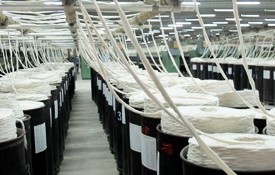
A factory corner of Nam Dinh Spinning Factory
With the advantages of automation, IoT (Internet of connecting everything, Big Data (Big Data), AI (Artificial Intelligence), etc, the industrial revolution 4.0 is creating great challenges and opportunities for Textile industry – a sector with a high proportion of the labor force.
The pressure created for industries that use a large number of workers in the manufacturing process will be enormous with the 4.0 technology wave, the speed of change will be exponentially fast as many predictions, not linear functions. counted as the previous revolutions. However, Industry 4.0 also opens up new opportunities. With the characteristics of the industry employing a large number of employees, along with a diverse system of equipment, the application of automation technologies will have a direct impact on the production process, helping to link data between equipment, reducing the number of direct machine labor.
The application of 3D printing technology allows creating products that meet the maximum needs of using products of users, reducing wastage due to overproduction, producing many types to welcome consumers. As a result, labor productivity will increase, creating opportunities for high-income workers, solving labor-intensive problems but unattractive income, high severance rate. With technology innovated in recent years, industry productivity has improved significantly. If 10 years ago, to create 1 billion USD for export, it would need about 80,000 – 90,000 new employees, now only need 50,000-60,000 new employees.
Textile industry with 4 main production groups is yarn, weaving-knitting, finishing dyeing and sewing with the rapid change of production technology. For the textile industry, from 110 people for 10,000 spindles, now just under 25 people, if the production is large, the stable product will be less than 15 people, the machine running speed will increase by 35%. Besides, labor productivity per capita increased by 6-10 times. The use of computerization and the use of large data have helped to increase the dyeing ratio to 100%, saving dyes and chemicals.
The application of scientific applications under the explosion of the 4.0 Revolution has created certain effects in the production of textile industry. Besides, the textile industry also needs to constantly monitor and update the world’s technologies, invest in expanding modern technology, and contribute to building the development of the industry in the future.
Productivity and Quality Office